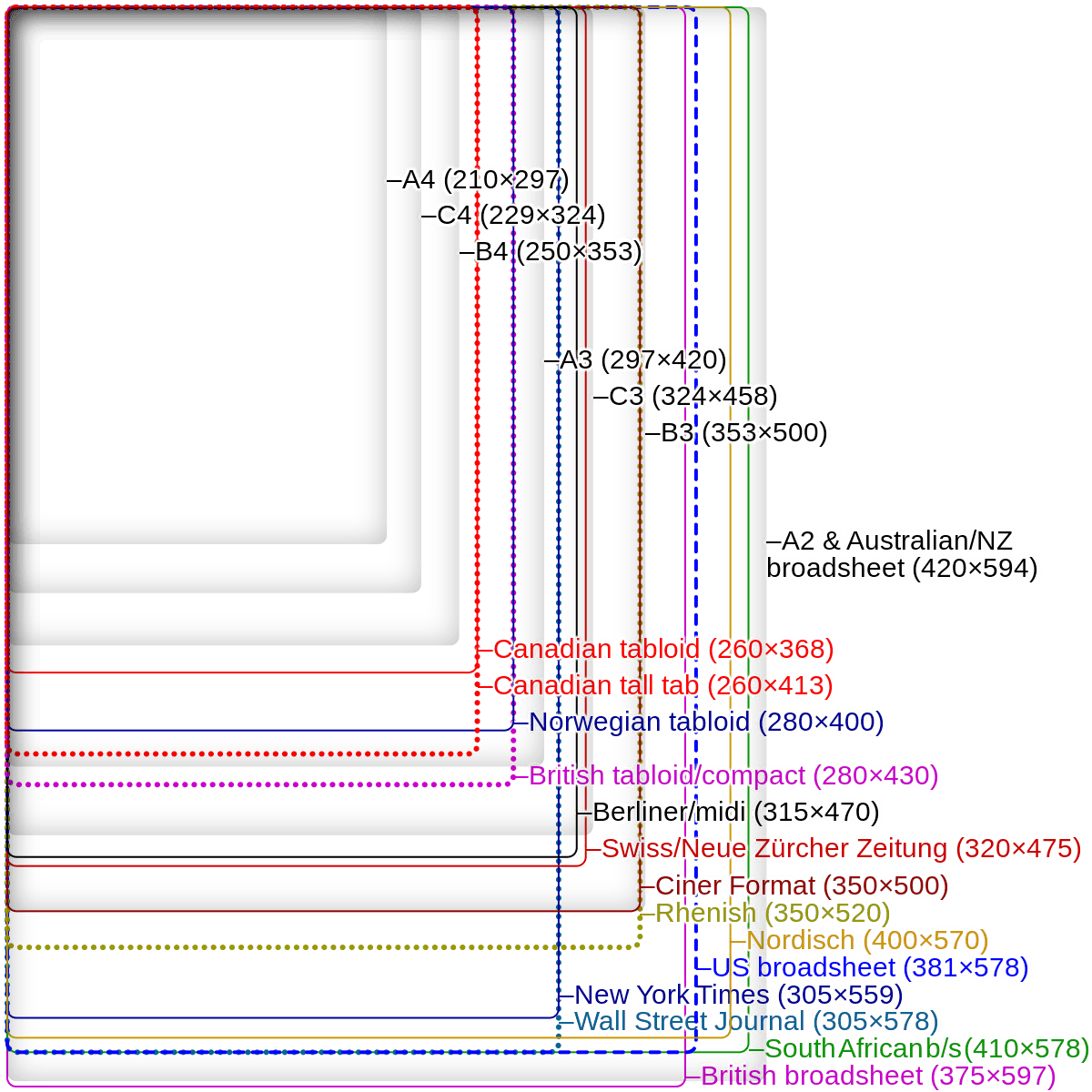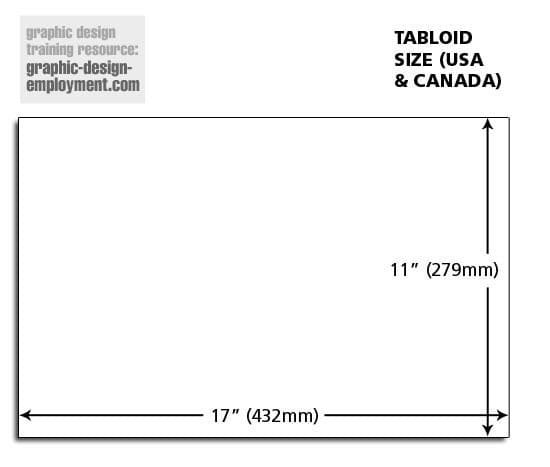There are so many kinds of paper sizes that we talked about – A Series Paper Sizes, B Series Paper Sizes, C Series Paper Sizes and so on. All paper sizes have their importance, and we can not discard any of them. Each of these is important for some particular purpose. Those purposes cannot meet without having the specific paper size. But there are still some paper sizes that we have missed. Can you think of one such paper that we use every day but haven’t talked about yet? We see it every day, read it every day, and still, it comes so far behind in the list? Not fair. Still can’t think of the name? It’s the Newspaper! We have not talked about Newspaper Sizes yet.
Newspapers are one of the most common things that we use every day. We read the daily news on newspapers, get aware of things happening in our society and also find job opportunities. Newspapers come to our homes every day. And most often than not they are quite big. Two of our hands are not enough to hold a newspaper. Have you ever questioned how difficult it would be to make a newspaper size paper? Very difficult.
Newspapers are generally very thin to help with transportation. As we sell them in bunches but this hampers the quality and durability. We know these things very well that newspapers can easily tear. Hence, it is a challenge to design paper that can maintain a balance between being easily transport and being durable. This is precisely why we need to know about the Newspaper Sizes.
Table of Contents
Newspaper Sizes
Newspaper Sizes have not been standardized under the ISO (International Organization for Standardization) and hence do not have standard sizes like other paper sizes. They generally print the newspaper on stock Newsprint paper of dimensions 24 in × 36 in which the uncut size of the paper has used in the newspaper. You can find more information about Newsprint paper stock uncut sizes here. This uncut size later cuts into smaller cut sizes.
[table id=16 /]The most common of these cut sizes are Broadsheet, Berliner, Tabloid, and Compact. These cut sizes are generally the sizes that we refer to when talking about sizes of newspapers because these are the sizes in which newspapers are delivered to our homes. It is a convention to write Newspaper Sizes as the size of the folded pages.
Broadsheet Size
Broadsheet Size has dimensions of 600 mm × 750 mm (23.5 in × 29.5 in).
However, in Australia and New Zealand, Broadsheet Size Newspapers are Newspapers printed on A1 Paper Sizes of dimensions 594 mm × 841 mm (23.4 in × 33.1 in).
Background of Broadsheet Size
In 1972, the British government imposed a tax on newspaper manufacturers based on the number of pages that were there in a newspaper. This movement by the government caused the manufacturers to print newspapers on biggest papers available and also reduce font and thus reduce the number of pages.
These newspapers started to print on single sheets of political satire and ballads which they sold on streets known as Broadsheet. Recently, Broadsheet is losing popularity, and many newspaper manufacturers are using Tabloid Size instead of Broadsheet Size.
Berliner Size
Berliner Size has dimensions of 315 mm × 470 mm (12.4 in × 18.5 in).
Background of Berliner Size
The word Berliner originates from Germany and German Language where a Berliner means something is having its origin in Berlin, Germany. So, it is possible that this Newspaper Size originated in Berlin, Germany. We also call the Berliner Size as Midi. It’s one of the most popular Newspaper Sizes among Newspaper Agencies in Europe. Although, there’s a Newspaper named “Berliner Zeitung” which is locally known as Berliner is not printed on Berliner Size Newspaper; hence it creates confusion about the Berliner Size amongst people.
Tabloid Size
The dimensions of Tabloid size are 280 mm × 430 mm (11.0 in × 16.9 in).
Background of Tabloid Size
The name Tabloid originates from the word Table. It can mean something easily kept on a table of smaller size. This is right for a Tabloid Size Newspaper- it can easily be read beside your tea on the table and won’t take up much space. It is the size of a modern full-size Tablet Device. The word can also be traced back to Tabloid Journalism which compacted stories into simple, short, and understandable forms. The Tabloid Size is often called as “The Half Size” of a Broadsheet Size Newspaper. Although, this is just a common perception, not reality because Broadsheet has dimensions of 600 mm × 750 mm (23.5 in × 29.5).
Tabloid Size is very close to the A Series Paper Size A3, which has dimensions of 297 mm × 420 mm (11.7 in × 16.5 in). Hence, it would be easy in the long term to make a transition from Tabloid Size to A3 Size for printing Newspapers because, nowadays, everything gets standardized. But even then, Tabloid Size is the most used size for Newspaper printing worldwide in countries ranging from the US, the UK, and Russia to India, China, Australia, etc.
Compact Size
Compact size has the exact dimensions as the Tabloid Size, i.e., 280 mm × 430 mm (11.0 in × 16.9 in).
When prominent Newspaper and Press Agencies like “High Brow” and “Quality” transitioned from printing newspapers in Broadsheet Size to printing in Tabloid Size; they wanted to use the size but wanted to avoid the aura of Tabloid Journalism that surrounded the Tabloid Size.
This is because they did not want their news stories to be compact, or small just because we print them on Tabloid Size paper– they are big agencies; they wanted to maintain their style of presenting news. Hence, at that time, Newspaper Agencies coined and started the term Compact Size. So, this was all about standard newspaper sizes.
FAQs
Is the size of all newspapers the same?
Newspaper formats vary greatly per country, with distinct formats being more widespread. The size of a newspaper format relates to the size of the paper page; depending on the newspaper, the written space inside might vary significantly.
What image size works best for a newspaper?
What are the two sizes of newspapers?
According to one classification method, this newspaper is divided into two major categories: broadsheets and tabloids. Initially, this category is only on page size. Typically, a tabloid is half the size of a broadsheet.
What is the size of a newspaper margin?
A half-inch (.5-inch) white margin must surround all four borders of each page (top, right, left, and bottom).
What units of measurement does the publication use?
The word GSM refers to the substantial weight of paper, defined as grams per square meter, and an area of the paper that remains constant regardless of sheet size. As a result, the paper thickness is in Grams per Square Meter (GSM).
What typeface is there in newspapers?
Even when bolded, its form is thinner than most other fonts, making it ideal for newspapers that wish to accommodate more content on a single line. Time New Roman has been the default typeface for numerous platforms and professions due to its popularity.
What distinguishes newspapers?
The newspapers come in folded newsprint paper. The paper used in newspapers is of low quality since it is created from a combination of recycled material and wood pulp and does not last long. Magazines, on the other hand, are printed on high-quality glossy paper.
How do you determine the size of a newspaper advertisement?
One can accomplish it by adding the columns and inches together. So a two-column-by-six-inch ad would be a twelve-column-inch ad. A 3-column x 5-inch ad is a 15-column-inch ad; a 5x16 is an 80-column-inch ad, and so on.










